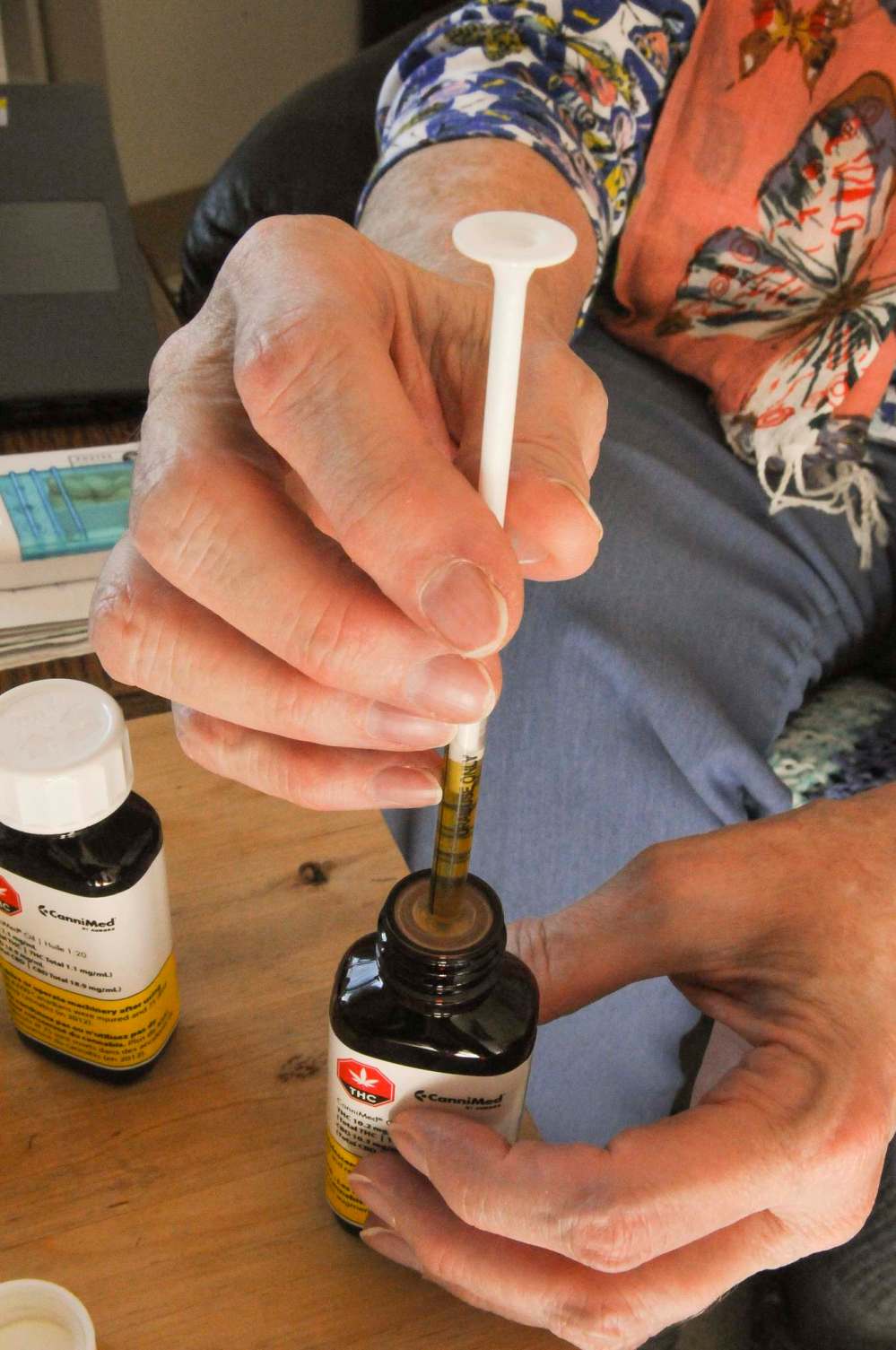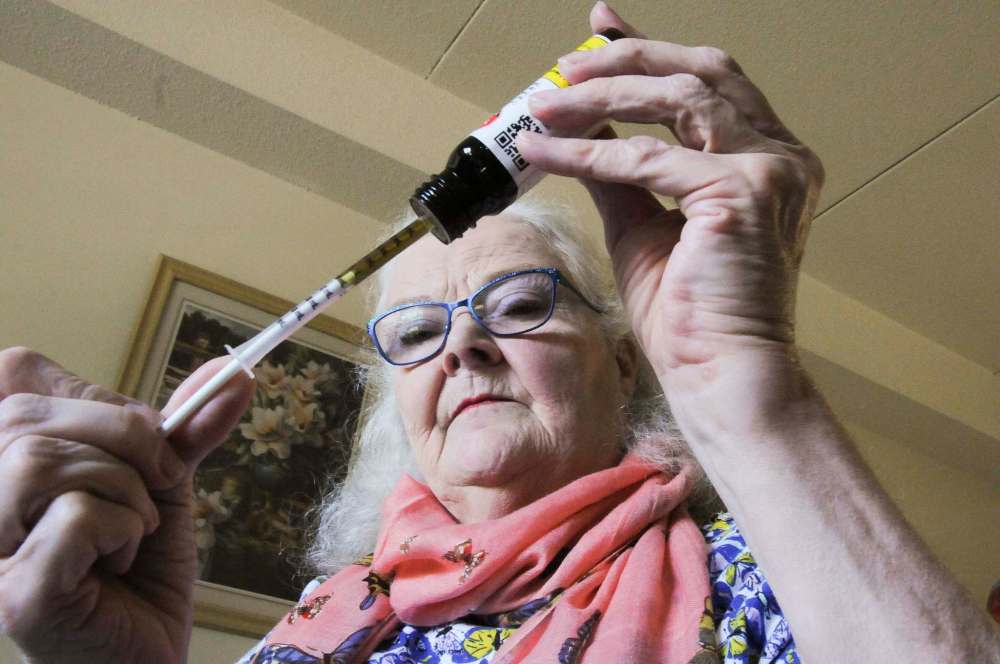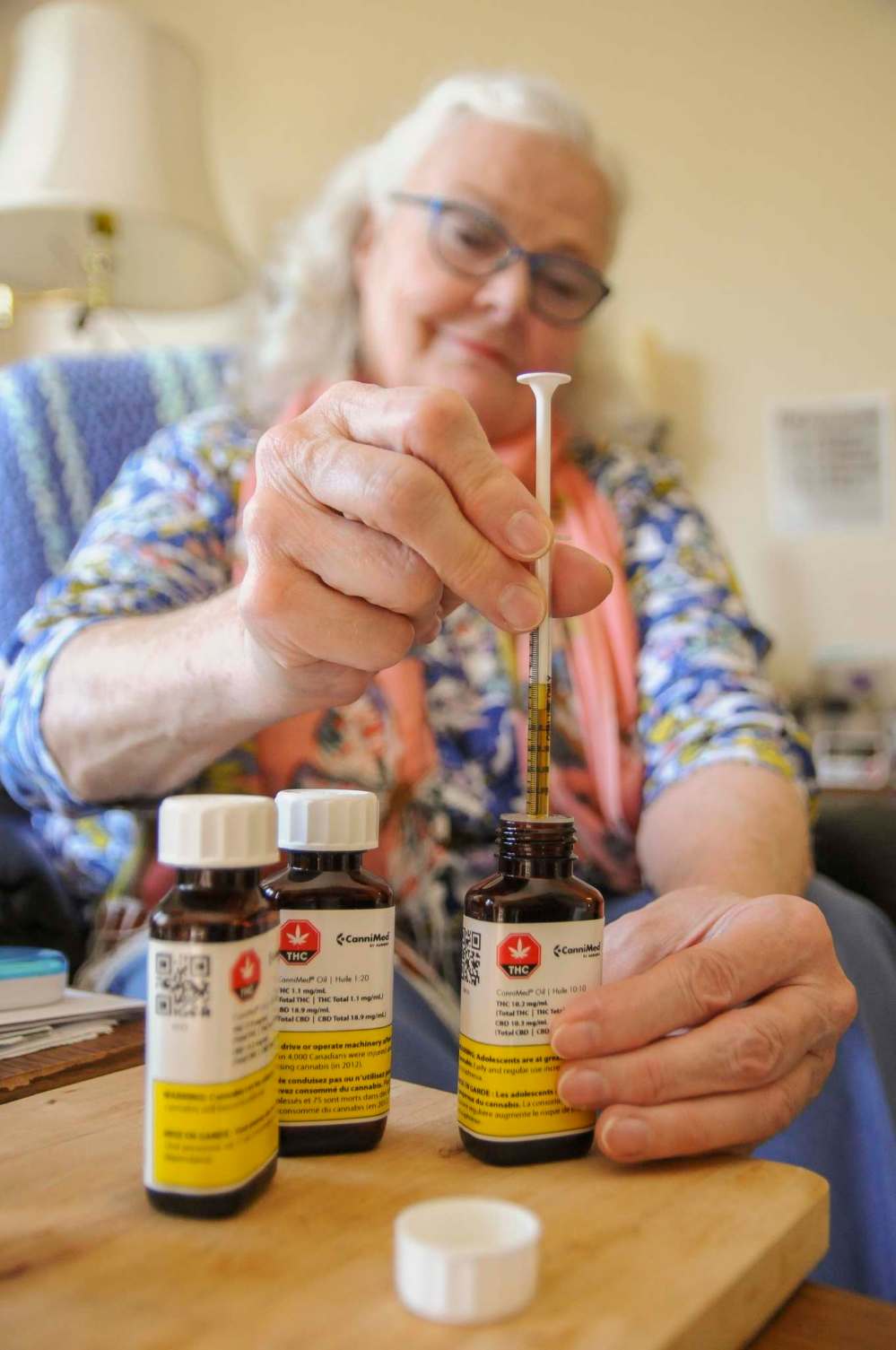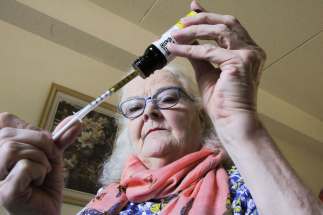Chronic pain, ‘chronic’ help Aging boomers turn to marijuana for relief, not for fun
Read this article for free:
or
Already have an account? Log in here »
To continue reading, please subscribe:
Monthly Digital Subscription
$0 for the first 4 weeks*
- Enjoy unlimited reading on winnipegfreepress.com
- Read the E-Edition, our digital replica newspaper
- Access News Break, our award-winning app
- Play interactive puzzles
*No charge for 4 weeks then price increases to the regular rate of $19.00 plus GST every four weeks. Offer available to new and qualified returning subscribers only. Cancel any time.
Monthly Digital Subscription
$4.75/week*
- Enjoy unlimited reading on winnipegfreepress.com
- Read the E-Edition, our digital replica newspaper
- Access News Break, our award-winning app
- Play interactive puzzles
*Billed as $19 plus GST every four weeks. Cancel any time.
To continue reading, please subscribe:
Add Free Press access to your Brandon Sun subscription for only an additional
$1 for the first 4 weeks*
*Your next subscription payment will increase by $1.00 and you will be charged $16.99 plus GST for four weeks. After four weeks, your payment will increase to $23.99 plus GST every four weeks.
Read unlimited articles for free today:
or
Already have an account? Log in here »
Hey there, time traveller!
This article was published 26/07/2019 (2332 days ago), so information in it may no longer be current.
Afflicted with osteoarthritis, fibromyalgia, spinal stenosis and a handful of other medical conditions, Alda McMillan is intimately acquainted with chronic pain.
“I lived in the Yukon — I’m a big Yukon mama, and I’m not a wuss about pain,” jokes McMillan, 71, who lives in a seniors’ housing community in Thunder Bay.
“But it was to the point where I just felt like I didn’t know how much longer I had in me. And I was looking at these 90-year-olds, thinking, ‘Oh my God, another 20 years of this?’”

McMillan laughs.
“But it’s good now.”
Relief came in the form of oils extracted from marijuana plants grown by government-regulated producers and used (sub-lingually or orally) under doctor supervision.
“It was huge,” she says. “I started off low like they recommend, and I gradually increased. And the difference was like night and day. I found that I was forgetting to take my regular dosing of morphine, because I wasn’t in the pain that drives you to take it.”
Since she starting using oil about six months ago, there has been a reduction in pain, allowing McMillan to use her walker more and wheelchair less frequently. That means more time out in the world, exercising and participating in a chronic-pain management program in her community. She also relies on weed oil to help her get a good night’s sleep.
“It makes such a difference,” she says. “Oh, God, those simple things like sleep and being somewhat pain-free.”
She has joined the ranks of Canadian seniors seeking marijuana and its derivatives for the relief of rheumatic pain, a trend some doctors say is on the rise. McMillan uses it under the supervision of Dr. Shelley Turner, who practises in both Thunder Bay and in her hometown of Gimli.
Most of Turner’s patients are over the age of 50 — many are past 70 — but they share a common interest in CBD, or cannabidiol, a chemical compound produced by cannabis plants. Roughly two-thirds of her patients arrive with an interest in trying weed to ease the symptoms of arthritis or similar conditions, she estimates.
“They hear about it in the paper, they hear about it on the news,” she says. “I mean, it’s everywhere. So it’s media, but it’s a lot of word of mouth. And people trying to help people.”
Some of her older patients are, nevertheless, reluctant to give it a try.
“There are people who are absolutely desperate,” she says. “They’re well into the whole (cannabis) stigma…. Then there are the people that are completely open and (say), ‘Really, please just help me, I don’t want to take all these pills anymore, I want to feel better.’ And then you have people that have been using cannabis for a long time.”

No one is counting exactly how many Canadians are using cannabis to ease the symptoms of rheumatic diseases and disorders, a broad family of conditions that often result in debilitating, chronic pain. But as of June 2013, 65 per cent of Canadians registered to legally use the drug for medical purposes had a diagnosis of “severe arthritis,” says Health Canada data uncovered by a 2013 access to information request from physician and McGill University researcher Mary-Ann Fitzcharles.
Since then, the number of Canadians signing up for the medical cannabis regime administered by Health Canada has only grown, and many more Canadians appear to be using it medically outside that system. Registering with Health Canada requires a doctor’s note, called a “medical document” in bureaucratic language. Statistics Canada estimates 479,100 people used pot for medical purposes with a medical document in the fourth quarter of 2018, but 620,400 — or 30 per cent more— used it without one.
● ● ●
Dr. Carolina Landolt sets aside two practice days every week to see patients referred by other doctors. The Toronto rheumatologist started taking an interest in 2015, recognizing a dearth of expertise as Canada’s medical cannabis laws opened up.
“From a basic science point of view, from a clinical point of view, from a pharmacological point of view, we know very, very, very little.” – Dr. Carolina Landolt
Landolt says cannabis shouldn’t be considered a treatment for arthritis and other rheumatic disorders, since it’s not known to address the underlying problems behind those conditions. Instead, it may provide symptom control for some patients by alleviating pain and some of its unwelcome companions, such as insomnia.
That effect has to do with the way cannabinoids — compounds such as CBD and its psychoactive cousin THC — interact with the endocannabinoid system, a series of receptors scattered throughout the nervous system helping to regulate various physiological processes. The endocannabinoid system interacts with endocannabinoids, which are naturally-produced chemical compounds, but it also responds to cannabinoids produced by marijuana.
“The idea is, is that the binding, or the engagement of the (cannabis) cannabinoids to these receptors modulates their effect,” Landolt says.
“Honestly, beyond that, it just gets all very nuanced. But the idea is, is that we have an endocannabinoid system which is a control mechanism that is distributed throughout our body and controls many many different functions, and that the engagement of the system by the cannabinoids is the way they mediate their effects.”
But even cannabis-friendly physicians such as Landolt have more questions than answers about the way marijuana might affect rheumatic pain. Can any of the other more than 100 cannabinoids in the plant play a role? Is there an ideal ratio of cannabinoids to use for pain relief? What’s the best way to administer those cannabinoids? When’s the best time to dose?

“I would say that the list of questions is infinite at this point,” she says. “From a basic science point of view, from a clinical point of view, from a pharmacological point of view, we know very, very, very little.”
Regardless, it appears to be doing something for some of the roughly 2,000 cannabis-curious patients who have come to Landolt’s rheumatology clinic since 2015. About 80 per cent of them end up trying weed, and Landolt estimates that about two-thirds report some benefit.
She treats each authorization as a trial run.
“Medical cannabis is not magic,” she says. “It doesn’t work for everyone, and not everyone can take it; even if you’re looking at CBD and non-intoxicating cannabinoids, some people have side-effects, as you would with any other medication, right?”
A typical patient referred to Landolt’s clinic is between the ages of 50 and 70 and most don’t know much about using the drug medically.
“So they’ll say things like, ‘Well, I don’t want to smoke,’ which, obviously, is not what we recommend,” Landolt says, adding she typically recommends orally-administered oils, in part because their effects can be long-lasting.
“Or, ‘I don’t want to get high,’ which, obviously again, is not something that we’re in any way promoting. To us, the intoxicating effects of THC are a side-effect that we avoid.”
● ● ●
Swelling interest in cannabis from patients led the Canadian Rheumatology Association to issue a formal position statement earlier this year.
“(We) felt it was necessary to at least inform our members about the information that is available, that they could discuss with their patients,” says association president Dr. Vandana Ahluwalia, a rheumatologist practising in Brampton, Ont.
The statement is cautious, but it also opens the door for physicians and patients to find common ground. It tells rheumatologists that even though top-quality scientific evidence of the efficacy of cannabis for rheumatic disease is lacking and the long-term risks unknown, patients may choose to try it. Rheumatologists are advised that any trial of medical cannabis should be focused on reducing risks and avoiding contraindications.

Ahluwalia says certain conditions, like rheumatoid arthritis, psoriatic arthritis or ankylosing spondylitis, already have good therapeutic options that don’t involve weed.
“But we have other painful conditions — osteoarthritis, fibromyalgia, and so forth — that sometimes we don’t have great treatments for. So it’s possible that medical cannabis could fill the void in between.”
The lead author of the position statement was Fitzcharles, a practising rheumatologist and McGill University associate professor of medicine, and the researcher who found, via access to information, that about two-thirds of Canadians registered to use medical cannabis in 2013 had an arthritis diagnosis.
These days, Fitzcharles says she’s asked about the drug during “every single clinic” — she recently got the question from a 102-year-old patient — and she’s willing to write prescriptions.
But she is more interested in clinical evidence than anecdotal, and points out that the existing handful of pharmaceutical-grade medical cannabis preparations have undergone only a few small clinical trials related to rheumatic disease.
“We absolutely need evidence,” she says. “The bottom line is that cannabinoids may be a very, very useful tool in the (treatment) of rheumatic diseases. We honestly do not know. And in this day of evidence-based medicine we cannot sit back, and accept on face value, anecdote.”
To that end, she is leading a group of McGill colleagues in launching a clinical study related to the use of cannabis by fibromyalgia patients. She’s reluctant to provide more details, but says legalization hasn’t removed all the barriers to cannabis-related research.
“Really, to get Health Canada authorization to proceed with a study of medical cannabis is still very tedious,” she says. “We have to jump through a lot of hoops.”
● ● ●
Jumping through hoops is a familiar experience for older Canadians such as McMillan, who want to use medical marijuana.

First, there’s the cost. McMillan spends nearly $250 on cannabis oil every month, even after discounts from the compassionate pricing programs some medical suppliers offer to low-income clients.
“Now that may not seem like a lot for some folks, but when you’re on a very low income, or a fixed income, it makes you squawk,” she says, pointing out that her drug plan covers the cost of morphine, but not marijuana.
“Really, to get Health Canada authorization to proceed with a study of medical cannabis is still very tedious,” she says. “We have to jump through a lot of hoops.” – McGill University researcher Mary-Ann Fitzcharles
Then, there’s the challenge of obtaining weed through the government regime. After getting a prescription from a doctor or a nurse practitioner, clients must register directly with one or more licensed producers, who can ship the drug after it’s ordered online or by phone. McMillan is registered with three producers, to ensure a steady supply of oil in the event one or more experience shortages. The logistics of signing up and ordering were a nightmare, she says.
“That would have stopped me, had I not been as stubborn as I am. And I know that a lot of people, a lot of seniors, would have fell back,” she says. “They wouldn’t have tried. And they couldn’t have tried. Some of them don’t have the wherewithal to be able to do that, to fight through.”
Canada has no legal bricks-and-mortar storefronts for medical cannabis sales, which McMillan sees as a barrier for seniors accustomed to getting their medication at local pharmacies. Even at the new, legal recreational marijuana stores spreading across the country, the supply of CBD-rich products can be inconsistent.
Turner suspects older Canadians are turning to those stores.
“The majority of the people in there have grey hair,” she says. “They’re hungry for education.”
Turner believes staff at the stores area doing the best they can to help, but says they’re limited as to what they can say and talk about, and they’re not medical professionals. She worries some vulnerable older patients may be turning to weed without proper medical supervision.
“(For) the cannabis-naive people, especially people who may be taking lots of medication — they may be on blood-pressure pills — cannabis without education potentially can cause some problems,” she says.

Back at McMillan’s building, it’s likely she’s not the only resident using medical marijuana, although nobody is discussing it openly, she says.
“It seems to be, still — because it was just recently legalized — that people are still afraid to talk about it. They don’t want to look into it.”
But Landolt says she’s witnessed first-hand how word gets around among her senior patients. Sometimes, all it takes is hearing about weed’s effects from a peer.
“I mean, I see that in my practice, where I have one patient and then it works for her, and then she’s telling everyone in her aqua-fitness class,” Landolt says, laughing.
“I joke, but honestly, that has happened more than once. A patient will be like, ‘Oh, my friend at aqua-fitness,’ ‘my friend at yoga,’ ‘my friend told me at work, (it’s) great for her back.’ So that’s what I see. I see that. There was a huge stigma… and I would say that the minute they hear from their peers that it has worked for them — or that they tried it and nothing bad happened, even if it didn’t work — they’re much more open to considering it as an option for themselves.”
solomon.israel@theleafnews.com
@sol_israel










